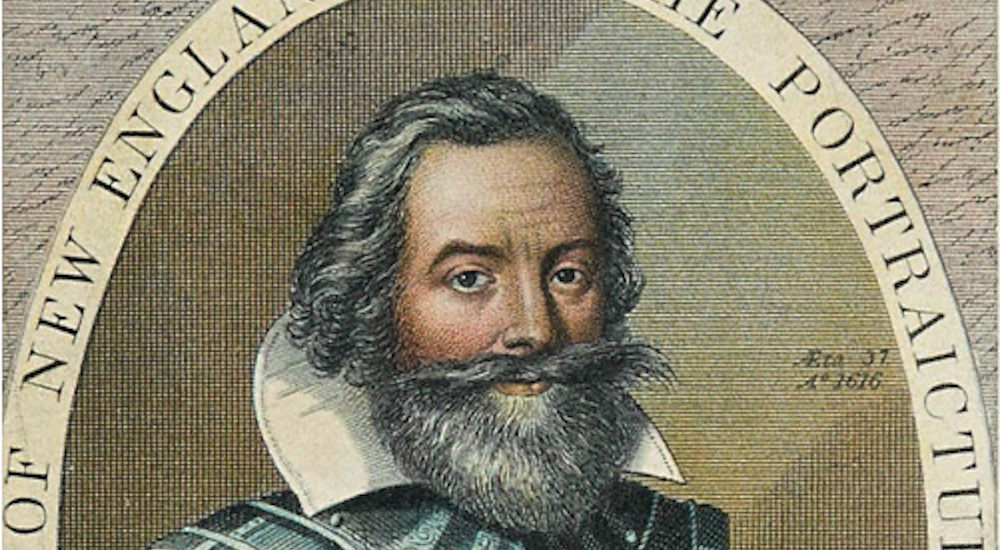Happy Thanksgiving from Caroline County, Virginia
The first in a series this Holiday Season relating Caroline’s role in the colony and future Commonwealth of Virginia-Part 1
This Thanksgiving travel back in time with me to another November, where the inhabitants of the Jamestown colony were not expecting a turkey to show up for any celebratory dinner. In 1607, the English colonists were already plagued by both inept leadership and starvation. One of their leaders, the controversial Captain John Smith, started to journey in the late fall, making trips inland to trade with the Indians for badly needed food. Arriving with an English ship under the banner of the Virginia Company earlier in April, Smith had begun exploring right away and was already familiar with some of the land and waterways. His maps are amazingly accurate and on the four rivers which drain present day Caroline County; the Pamunkey, the Mattaponi, the South Anna and the Rapphannock, there are symbols marking those rivers all the way to the fall line in Fredericksburg.
The real story of Caroline County is fascinating and lies not only in the diverse waterways and geography that make up this unique county, but in what historian Elliott Campbell wrote in his Colonial Caroline, our “Political Genius.” There was no “Moonlight and Magnolias” here in the early days, but a bevy of hard scrabble pioneers and progressive land barons who cared little for established thinking, the Royal Governor and England. Bucking the system, as we shall see in this series, Caroline, even after she was formally accepted as a county, still managed to become at the time of the American Revolution, the third most populous and influential county in the Colony of Virginia and a hotbed of revolution.
The lands that would one day make up Caroline were an important key to the expansion from the original Jamestown settlement. Here was the official line of the Virginia “frontier” and to strike out beyond the established settlements of Jamestown, and later Williamsburg known then as Middle Plantation, was to venture into unknown and highly dangerous territory. In fact, until the time of Nathanial Bacon and his rebellion, it was actually illegal by royal statute to venture into the land which would become Caroline County. Virginia.
A few brave souls, mostly military men defied this edict and moved across the frontier and were by their very nature, rebels who drew other rebels to them. They were far enough away from the royal government on the James to do as they pleased and their loyalties were to each other and the lives they carved out for their families from the wilderness. Their women and children came with them to this perilous frontier. There are written, first hand accounts of the forts that were built instead of houses and escape tunnels which lead to fields and forests, so fierce were the Native Americans in defense of their land. It is a story of incredible people, rivaling the Jamestown chronicles with its cast of brave-hearted adventurers, the descendants of which still live in Caroline and the Commonwealth today.
Four hundred years ago, Captain John Smith would become a part of this history, and was the first white man to explore Virginia’s waterways in the fall of 1607. He was taken prisoner in December of 1607 by the Native Americans while exploring the headwaters of the Chickahominy. His captors brought him down the Pamunkey River on his way to face the judgment of their chief, Opechancanough. When he reached the Pamunkey Village of Cattachiptice at the confluence of the North and South Anna Rivers, John Smith and his Indian captors rested in land which would become Caroline County.
Smith was a man of tremendous physical courage and used his arrogance to extricate himself from a number of deadly situations. When he reached the Pamunkey seat of government, at what is present day West Point, it was decided Smith was too important a prisoner for the judgment of Opechancanough. He was sent to the Algonquian Capital near Gloucester to be judged by the powerful overlord, Powhatan. On his journey, Smith was paraded before each of their chiefs at their tribal seats. This was to show as many as possible that white men were not Gods, but flesh and blood. At Powhatan’s capital, Werowocomoco, Smith would meet for the first time the most famous Native American of all time. Her given name was “Mataoka,” but the world would know her as “Pocahontas” and as legend has it, the favorite of her father, Powhatan.
It was he who gave her the nickname, “Pocahontas” which means “naughty one” or “little playful one.” According to Smith who wrote of the incident seventeen years later, he was brought before the great chief. He was sentenced to die but before the blow could fall, the princess laid her head protectively over his. Powhatan spared Smith’s life and adopted him into his tribe as an honorary son. Historians disagree on why Smith’s life was spared. The old adage “keep your friends close but your enemies closer” may have applied here. Powhatan most likely sought to keep an eye on these interlopers and also may have had ideas of subjugating the colonists and incorporating them into the Powhatan nation.
He returned Smith within a month to the Colonial Capital in Jamestown with an escort of honor. Using Pocahontas as an emissary, the chief sent food to Jamestown, helping them to survive the harsh winter. The Native Americans taught the colonists how to stalk game silently in the woods, how to make canoes from hollowed out tress, how to grow Native American vegetables and where to find edible fruits and berries.
No sooner had he returned to Jamestown, the undaunted Smith immediately began to make plans for another expedition. In 1608, he sailed his ship, “Discovery” up the Rappahannock, exploring a portion of Caroline and continued into what would become Spotsylvania County. Sometime the same year, he made his way back to Caroline, and visited the Native American village of Doguetown, near present-day Milford.
Upon his arrival back in Jamestown, Smith was forced to resume a harsh role as the colony leader when he found the men refusing to work to grow food or fortify their defenses. In September 1608, Smith became president of the colony’s council. He insisted on rigid discipline, new and better defenses, and mandated farming with his order that all must work or face starvation. Smith had settlers dig the first well inside the fort protected from the threat of Indian arrows and ordered the expansion of the fort into a five-sided structure, which archaeologists have since found in this century. Smith’s strong leadership ensured the survival of the colony, but made him serious enemies at Jamestown.
A mysterious powder explosion near a boat he had been sleeping in on the water, left him seriously injured and he returned to England to recuperate. With him went the colony’s most adept Indian negotiator, trader and a man who knew how to intimidate when necessary to save lives. In the following years, relations with Virginia’s native peoples deteriorated. Powhatan forbid his people to trade or communicate with the settlers and he actually laid siege to the fort hoping to force them to leave. By 1609, at the end of what became known as the “starving time,” when a resupply ship from England arrived, there were only 60 left from the original 500 settlers. Smith never set foot on Virginia soil again.
Since the focus is always on Jamestown, most people do not realize the importance of Caroline’s role in Powhatan’s empire. Although his territory was vast, its core and very heart lay between the James and the Mattaponi Rivers in the inner coastal plain. Thus, land that would become Caroline County was an integral part of the history of the Algonquian people. There were three documented tribal seats in Caroline. The Chief of the Dogues held his seat between Milford and present day Devil Three Jump. The Secobec Chief lived near Corbin, and the peace loving Nantangtacund’s leader lived on the north side of Portobago Bay. In addition to these seats, there were at least six other villages in the county. It can certainly be said that Caroline in 1607 was an important seat of government for the Algonquian people, all owing allegiance to Powhatan.
When I was growing up here, we often hiked and hunted the river beds where the evidence of the Native American culture and life was still abundant in the number of arrow heads and tools which would be found in the hundreds. Recently the collection of the late Agnes Skinner who lived along the Rapphannock and who searched for decades during her lifetime for artifacts, was lent to the Port Royal Museum of American History. These relics included thousands of arrowheads, tomahawks, axes, stone bowls, clay ware and a bone fish hook. The jewel in the crown is an amazing silver medallion bearing the inscription, “King of Machohick.”
Perhaps one of the most important Virginia Indian artifacts ever discovered was unearthed in 1832, at historic Camden, an estate located close to the Skinner property on the Rappahannock in Caroline. This was a silver medal inscribed with “King of the Patomeck” which now resides in the Virginia Historical Society. English law required these badges be made to allow for unhindered passage when the Indians came into areas settled by the English
In school, in the 1960s where real geography and the history of our county was still being taught and not considered politically incorrect to mention, we understood the very different and distinct geographical dividing lines of Caroline County and the histories associated with them. The sheer size of the county, 537 square miles is its first defining characteristic. On the southern border of Caroline and to the east, is Reedy Church, an area we called the “flats” after the lowlands and swamps which stretch toward Richmond and the James River. This is also where our much beloved Mattaponi River, winds from border to border and leaves Caroline headed for the county of King and Queen.
Here too, the legendary Pamunkey River makes its way through our county. I was always told as a child that the Caroline part of this river had been the seat of the Pamunkey Indian Queen, Anne, but more about her later. In this southern part of Caroline, also is where the “Old Stage Road” the oldest north/south road in the Colony of Virginia and the main thoroughfare to the Colonial Capital, continues on headed toward what was considered in the 17th and 18th Century, civilization. Moving northwest in Caroline there was a hamlet called Ladysmith and the Telegraph Road of Civil War fame and the way to the mountains. Traversing east and north to the Rappahannock River, one finds the colonial Seaport of Port Royal. Here the swath of land lies in the Tidewater, that magical low triangle of earth, known as the “Birthplace of Presidents.
No other large county in Virginia lies in both the Piedmont, the Tidewater and in between and even today, despite there being no urban center of commerce or traffic, it can take as much as an hour to travel from one end of our vast county to the other. These areas and their original Native Inhabitants would play a major role in when and who settled the Virginia frontier and beyond. Historians have often written that Caroline County was “The Gateway.”
Next week’s post – A Look at Virginia’s Native American Inhabitants and Bacon’s Rebellion Opens the Frontier


